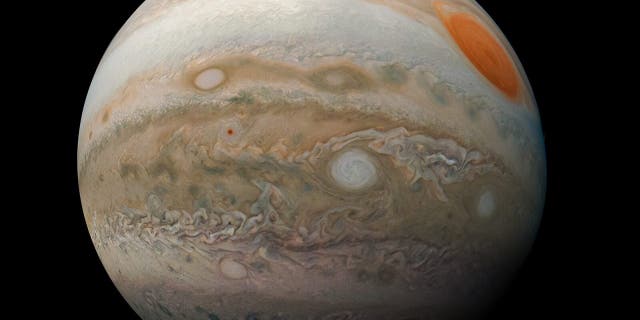NASA recently extended the life of two of its planetary discovery missions, including the Juno mission to Jupiter. Now it’s come to light Juno has discovered an FM signal emanating from one of the gas giant’s moons, Ganymede.
The discovery is not an indication of extraterrestrial life, but it is fascinating nonetheless, given it’s the first time it’s been discovered coming from the celestial satellite.
“It’s not E.T.,” Patrick Wiggins, one of NASA’s ambassadors to Utah, said in comments obtained by Fox 8 Cleveland. “It’s more of a natural function.”

Natural color view of Ganymede from the Galileo spacecraft during its first encounter with the satellite. North is to the top of the picture and the sun illuminates the surface from the right. The dark areas are the older, more heavily cratered regions and the light areas are younger, tectonically deformed regions. (NASA/JPL)
The spacecraft, which launched in 2011, happened to be traveling across Jupiter’s polar region at a speed of 111,847 mph when it crossed the radio source, known as a “decametric radio emission,” or simply Wi-Fi. It saw the radio emission for only five seconds, but it was enough time to confirm the source.
According to NASA, the decametric radio waves have frequencies between 10 and 40 MHz, but never above 40 MHz. “Electrons spiraling in Jupiter’s magnetic field are thought to be the cause of the radio noise we hear,” the space agency added.
Scientists have known about radio waves on Jupiter since the mid-1950s, but this is the first time the phenomenon has ever been seen emanating from Ganymede.
The findings were recently published in the scientific journal Geophysical Research Letters.

While notable, this is not the first time scientists have discovered strange occurrences on Ganymede. In 2018, researchers observed “extraordinary” electromagnetic waves, also known as “chorus waves,” thanks to the Galileo Probe spacecraft.
Jupiter’s moon Ganymede has long fascinated astronomers—as it is the largest of the planet’s moons. In 2015, NASA’s Hubble Space Telescope spotted evidence that Ganymede has an underground ocean.
Juno has made a number of discoveries about Jupiter, including capturing remarkable, never-before-seen images, as well as a “snow-white” oval storm.
The Juno mission launched in 2011 and was scheduled to stop functioning in July 2021 but will now continue until September 2025 or the end of its life, whichever comes first. Not only will Juno continue to observe the gas giant, but it will also look at the planet’s rings and its moons, including “close flybys” of Ganymede, Europa and Io.

Citizen scientist Kevin M. Gill created this image using data from the spacecraft’s JunoCam imager. (NASA/JPL-Caltech)
Europa, the sixth-largest moon in the solar system, is home to an ocean that “could be habitable,” researchers have previosly said.
Source: Fox










